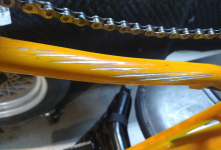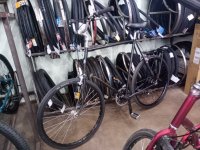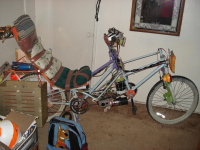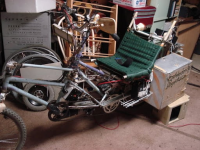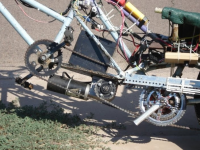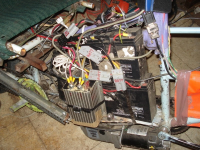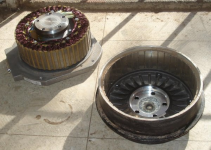jetpackjbd
100 W
For a while now my eBike has had a loud clacking noise coming from the front wheel in random 1-5 second intervals and I couldn’t figure out what it was. I checked the spokes, brakes, and suspension but nothing seemed abnormal. The spokes were a little loose but adjustment didn’t yield any improvement. So I kept riding for a few months and ignored it.
Yesterday I noticed the noise was a bit more frequent so I pulled over to check everything again. Finally, I look down and:
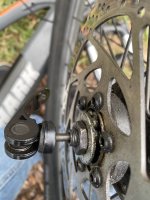
I’m pretty sure the balls belong inside the bearing… I loosened the nut that was barely finger tight and try to shove it back in place but I couldn’t fix it without tools so I just rode it home another mile. After messing with the bearing I must’ve made it even worse as a new death wobble appeared. Drive Home
I take the wheel apart and find a ball had completely shattered at some point.
 I spent a few hours trying to get the nut on the other side off so I could reinstall the seal but it wouldn’t move. Threads are all messed up and I couldn’t retread it all the way. So I reinstalled the seal incorrectly, cleaned up the metal shavings, and put in a spare ball I had. It works now and drives fine but definitely has more friction when you try to roll it by hand. I’ll probably need a new wheel in a few hundred miles.
I spent a few hours trying to get the nut on the other side off so I could reinstall the seal but it wouldn’t move. Threads are all messed up and I couldn’t retread it all the way. So I reinstalled the seal incorrectly, cleaned up the metal shavings, and put in a spare ball I had. It works now and drives fine but definitely has more friction when you try to roll it by hand. I’ll probably need a new wheel in a few hundred miles.
Learn from my mistake, figure out the problem before it gets worse!
Yesterday I noticed the noise was a bit more frequent so I pulled over to check everything again. Finally, I look down and:

I’m pretty sure the balls belong inside the bearing… I loosened the nut that was barely finger tight and try to shove it back in place but I couldn’t fix it without tools so I just rode it home another mile. After messing with the bearing I must’ve made it even worse as a new death wobble appeared. Drive Home
I take the wheel apart and find a ball had completely shattered at some point.
 I spent a few hours trying to get the nut on the other side off so I could reinstall the seal but it wouldn’t move. Threads are all messed up and I couldn’t retread it all the way. So I reinstalled the seal incorrectly, cleaned up the metal shavings, and put in a spare ball I had. It works now and drives fine but definitely has more friction when you try to roll it by hand. I’ll probably need a new wheel in a few hundred miles.
I spent a few hours trying to get the nut on the other side off so I could reinstall the seal but it wouldn’t move. Threads are all messed up and I couldn’t retread it all the way. So I reinstalled the seal incorrectly, cleaned up the metal shavings, and put in a spare ball I had. It works now and drives fine but definitely has more friction when you try to roll it by hand. I’ll probably need a new wheel in a few hundred miles.Learn from my mistake, figure out the problem before it gets worse!


